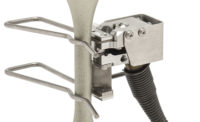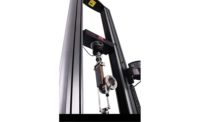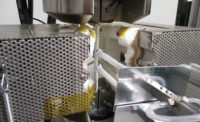Active thermography is a young yet highly efficient and powerful technique for NDT in aerospace. With a focus on the inspection of composite materials it offers many advantages.
The use of composites is increasing rapidly in the design and manufacturing of aircraft. For military and sport aircraft, composites are an indispensable material. In commercial aviation this trend led to new-generation aircraft such as the Boeing 787 and the Airbus A350 with a very high content of main structural elements manufactured from carbon graphite composites.
Although for designers the advantages associated with the use of composites are obvious, these materials present many new challenges for inspection and maintenance practitioners. To ensure high safety standards and cost-effectiveness, advanced NDT methods are required that fulfill a multitude of requirements. These include: accurate detection of the different defects typical for composites; easy operability; rapid inspection of large areas; in-service inspection without extensive disassembly or the need for special facilities; easy analysis of the inspection results independent of the experience of the inspector (less dependence on the ‘human factor’), and easy archiving of the results for traceability.
Generally these requirements can be fulfilled by systems based on active thermography. In recent years a great effort has been made to improve this technique and make it user friendly. Thermography has been completely introduced into international NDT standards such as NAS410 and the EN4179. In the aerospace industry active thermography is used in a growing number of applications as the primary NDT method. Although in the past thermography equipment was very expensive, recently developed portable systems are now available at the price of good ultrasonic testing equipment.
Thermography - How it Works
Active thermography is based on inducing a heat flow on the part to be inspected. This can be done either by applying energy in a pulsed form (pulsed thermography) or in a harmonic modulated way (lock-in thermography). The propagation of the heat flow inside the object directly affects the temporal behavior of the surface temperature. By recording the surface temperature with an infrared camera and by applying an appropriate mathematical analysis, an image is calculated, which shows the internal structure of the part with the defects. Active thermography offers different inspection methods as well as a variety of measuring techniques. So the measurement procedure can be optimally adapted to different materials and parts with different structural properties. The inspection methods mainly differ in the type of excitation source used, in the way the thermal energy is applied and in the mathematical analysis. Some inspection methods best suited for NDT of composite materials on aircraft should be explained.
Pulse Thermography
With the pulse thermography method, a short energy pulse is applied to the measuring object. High-energy flash systems are most commonly used. Typical applications are the inspection of thin-walled components or the characterization of thin layers. Main advantages of this technique are the short inspection times (< 1 second, up to a few seconds), and the ability to determine the depth of defects.
Transient Thermography
The measuring principle is similar to that of pulse-thermography. However, here the energy is applied in a rectangular form over a longer period of time. This allows the use of low-cost excitation sources such as halogen lamps or hot-air blowers. Inspection times are short and the depth of defects can be determined. Transient thermography is a particularly suitable inspection method for composite materials. This is valid for quality assurance during production as well as for inspections (ISI). Particularly in thin-walled components, defects can be revealed that are hard to detect when using classic inspection methods. With transient thermography the detection of such defects is not a problem.
Lock-In Thermography
With lock-in thermography the surface of the test object will be excited with periodical harmonic-modulated energy. Typical excitation sources are, for example, normal halogen lamps or hot-air blowers. The depth range can be set through the modulation frequency of the excitation source, in order to obtain the best possible result. Compared with the transient method, measuring times are considerably longer.
Vibro-Thermography
With this method power ultrasound is used as an energy source, which is coupled into the component to be inspected. The ultrasound energy is transformed into heat through rubbing at defect locations where cracks or delaminations are present. Defects therefore act as internal heat sources, while undamaged areas show almost no temperature increase. This gives a defect selective response (dark field method), i.e. only the defects are displayed with a high contrast in the resultant image, which allows for easy identification of same. Another advantage is the superior depth range of this method. However, vibro-thermography is not a contact-free method, as the ultrasound energy source needs to be coupled to the surface or component to be inspected.
Advantages of Active Thermography for NDT
Classical inspection methods such as the tap-hammer or ultrasound (phased array or single probe) are still widely used for the inspection of composite structures on aircraft. Besides other limitations, such as the dependency of the inspection results on the experience of the inspector, these techniques do not allow for the scanning of large areas in an economically efficient manner. Inspection methods for large area scans, such as shearography or scanning acoustical microscopy (SAM) are not really established and suitable for practical use. This is mainly due to high devicerelated complexity and limitations for in-situ inspections on aircraft.
Compared with those methods, active thermography offers many advantages. It enables large-area measurements that are performed contact free and fast. The inspection results are presented as high-resolution images, which enable easy interpretation and simple and efficient documentation. Modern inspection systems are easy to operate and do not necessarily require the measurements to be performed by an experienced inspector.
Moreover, adaptation to the size of the inspected part is easily done. A single measurement can cover an area of several square meters. However, parts that have a size of just a few millimeters can be inspected as well. Measuring times are short; a measurement on a thin part will normally just take a few seconds.
Technology and Applications
In the past, NDT systems based on active thermography were mostly designed for laboratory use. Due to the demand for in-situ inspection, some devices for mobile applications appeared on the market recently. In military aviation active thermography is already a frequently used NDT technique because here the approval of new inspection methods is normally done internally by the responsible military authorities.
Development and Application
A significant landmark for the development of an efficient turnkey inspection system, easy to operate and more affordable, was recently created for an application for Airbus. Airbus was in need of a system that was both mobile and very easy to use for the quick inspection of large composite areas on its aircraft, to detect and mark Structural Repair Manual (SRM) repairs for further NDT assessment. This was a very challenging task since good repair work generates almost no material inhomogeneity and is therefore very difficult to detect. Some repairs are only one layer thick, and the fact that there can be variations in the paint thickness or decal foils makes the job even more difficult. Above all, the system had be very easy to operate, so that inspections could be performed by airline employees on site and not necessarily by an experienced inspector.
Due to the demanding requirements, Airbus performed a very thorough analysis of the different NDT techniques available, to determine which would be the most effective. Among the different techniques taken into consideration was ultrasound phased array, but it proved to be too complex in the application, the measurements were too time consuming, and the analysis of the inspection results relied too much on the interpretation of the inspector. In the end Airbus chose active thermography as the most appropriate technique, but it discovered that there was no system available on the market that could meet all its initial requirements. Therefore Airbus decided to initiate the development of such an inspection system.
The final system consists of only two components: a measuring head and a tablet computer. The measuring head contains a highly sensitive infrared camera with integrated control electronics, as well as a heat source (halogen lamp) with integrated power electronics. All these components are mounted on a frame that contains three legs with vacuum-driven suction cups. The suction cups are for fixing the measuring head to the surface of the object to be inspected. This enables the inspection to be performed on horizontal and vertical surfaces. The head is designed for one-person operation: with two buttons located on the frame, the suction cups are controlled and a measurement is released.
The performance of the system and the required inspection times were checked in a series of tests by personnel without a NDT background. During those tests, the complete side of an A320 rudder could be checked for SRM repairs in just 2.5 hours.
When compared with other NDT techniques, the new system offers considerable advantages in terms of user friendliness, required inspection times, and the required qualifications of the test personnel. That is why Airbus has planned to qualify and use this new system increasingly for other inspection tasks on composite materials.
In the near future the operational use of new-generation aircraft such as the B787 and A350 will set new challenges for aerospace NDT. One example is the question of how the complete fuselage of a Boeing 787 can be checked for damage in a time- and cost-effective manner during a maintenance event. Moreover, the typical damage scenarios for normal operation, such as bird strike, lightning strike, impact of objects during takeoff or landing, or a collision with a ground vehicle also present problem areas for the inspection. These incidents necessitate an immediate and reliable assessment on site, in order to avoid expensive downtime periods. An inspection with phased array ultrasound could be an option; however, this method requires highly qualified NDT personnel, who will often not be available at the location of the incident. In contrast, active thermography offers the advantage of ease of use, which enables less qualified personnel to perform measurements. Since the measurement results are available as digital images, it is possible to send them to experts worldwide for their reliable assessment.
The implementation of remote inspections is also being discussed. Here, the on-site staff would just be responsible for the handling of the inspection system while the measurement and evaluation is carried out remotely by an expert connected through the internet. International committees, such as the Commercial Aircraft Composite Repair Committee (CARC) have been dealing with these problems for many years. However, many of the questions discussed have not been satisfactorily answered. Recently some large-scale research projects have been initiated to improve active thermography as an inspection technique for large-area inspections on composite aircraft structures. In these projects new approaches are being tested, such as the use of eddy current as excitation source, or the use of robot crawlers for performing automated measurements.
-Automation Technology GmbH
For more information, please visit www.c-checkir.com.




